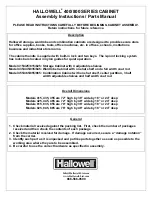
Roth DWT Installation Manual
12
Lubricating & Hydraulic Oil Storage and Dispensing
5. Locating the Tank
1.
Make sure the tank will fit through all doors, stairs, halls, and turns taken to reach its
intended placement. The tank cannot be dismantled or otherwise altered to make it fit
through smaller spaces and any attempt to do so will destroy its structural integrity as well
as void the warranty.
2.
Examine the desired tank location for deficiencies in the load bearing surface, such as
irregularities, slope, and dampness. If a level pad will be poured on the existing floor, it
should extend 6 inches past all exposed sides of the tank.
3. The tank must not be installed closer than 5 feet to the heating appliance (NFPA 31 – 7.5.6)
and cannot obstruct access to other utilities’ panels, meters, or control valves.
4. Because the connection points of the inner polyethylene tank project above the outer tank
top, the DWT must not be installed near a window that will allow exposure to sunlight (UV
radiation) on these connections. Although the polyethylene does have limited UV inhibitors
in it, prolonged exposure to sunlight can start breaking down the exposed plastic. The same
precaution applies to the clear plastic cover on the leak detector.
5. After the site is prepared, remove shrink wrap and other packing materials and thoroughly
inspect the tank and accessories for any hidden damage or missing parts. If damaged,
contact the wholesaler the tank was purchased from for resolution.
6. Once the inspection is complete, the installation can begin. Each tank has 4 connection
ports on the top. These can be used interchangeably during installation for the various tank
fittings, providing maximum flexibility for the planned connections.
The certification label on the tank should be visible after installation.
Tank Base Installation
1. The Roth EcoDWT plus 3 uses a one piece base assembly, known as a cradle base,
for support. This base is shipped on top of the tank to provide protection for the fitting
connections and is held in place by the shrink wrap plastic.
2. The base consists of two or more steel tubular “legs” running horizontally the full width of the
tank with the cradle assembly attached to them. The design of the base requires the legs
to be in contact with the floor for their entire length, or distortion and possible failure of the
base can occur.
3.
Once the site is ready for the tank to be set in place, simply set the base on the floor in the
approximate location the tank will be installed and place the tank on the base. There is no
need to connect the base to the tank, as it is designed to lock in place when the tank is filled
with oil. Once the tank is on the base, the unit can be easily slid to its permanent location,
allowing for proper clearances.
Failure to use the base may result in tank failure and will void the warranty.













































